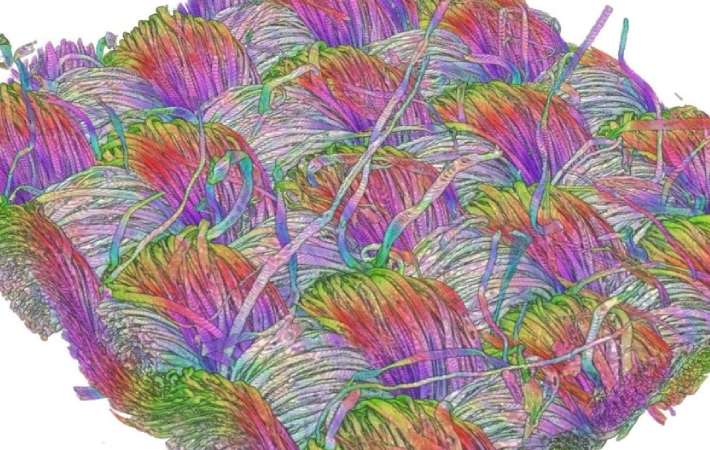Scientists at the North Carolina State University have found a way to know how itchy a sweater might be when worn directly against the skin, or how soft a blanket spread on bed can be. They have developed a process to measure fabric’s roughness using 3D imaging. The method can quantify skin-textile interface at a microscale without destroying the fabric.
In the journal ACS Applied Materials & Interfaces, researchers reported on a series of experiments in which they used an imaging tool – X-ray micro-computed tomography – to take 3D images of the surface of fabric in order to calculate the surface geometry, and measure the impact on friction. Their method can quantify skin-textile interface at a microscale without destroying the fabric.Scientists at the North Carolina State University have found a way to know how itchy a sweater might be when worn directly against the skin, or how soft a blanket spread on bed can be. They have developed a process to measure fabric's roughness using 3D imaging. The method can quantify skin-textile interface at a microscale without destroying the fabric.#
“We need ways to definitively measure friction to help the textile industry tune fabrics to be suitable for specific applications,” study’s corresponding author Kavita Mathur, associate professor of textile and apparel, technology and management at NC State, said in a press release. “We have textiles for apparel, for athletes, that are worn by patients, and that go into furnishings. Friction can be anywhere – not just against the skin. Ultimately, we envision using this method to ensure fabrics are not too abrasive for their end-uses, whether they are destined to end up on a hospital bed where irritation can lead to bed sores, or on an athlete or into furnishings.”
The textile industry currently uses tests that require an instrument, specifically a metal probe, that rubs back and forth against a small piece of fabric to give an indication of how rough or smooth the fabric is at the micron level. The metal probe represents neither our skin properties nor the actual interaction, according to Mathur.
“My graduate student, Ruksana Baby, is working on a friction test method capable of mimicking the human skin response to fabric at varying conditions. This will allow us to investigate skin-textile interactions for diverse applications like sports apparel, health care and medical textiles, military apparel, firefighter’s protective clothing and more,” Mathur said.
Mathur said: “Images were taken using a computing device – a new instrument at our labs in the Analytical Instrumentation Facility – to take an image of a cross-section of the length and depth of the fabric. So, we know exactly, layer by layer, how the fabric was composed. It’s non-destructive in terms of getting inside the fabric. This tells us the geometry of the fabric from the fibre level to the fabric level.”
“Then we sandwich the fabric between an artificial skin simulant at a certain pressure to press on all the fibres, and that gives us what the true contact area is on the surface. Then we take the image of that sandwich. The exerted pressure at the contact interface will change the fabric’s surface geometry, and that’s recorded by the instrument very precisely,” she explained.
Mathur said that just by changing the fabric structure alone, frictional interaction with the skin can be changed. Because different fabric surfaces create different interactions with skin. “Since we can’t see it with bare eyes, we used a CT scan to capture fabric images in a non-destructive way so we can see how the fabrics are contacting the skin, and investigate why the contact is different.”
The selection of fibres and yarns, as well as the fabric structure, help tune the frictional property of textiles. “For instance, you will see your cotton T-shirt feels different than your active wear, which is typically made from synthetic fibres,” she said. In some applications, depending on the type of fibre used, there can be short fibres protruding from the fabric surface, known as fabric hairiness, which can lead to skin irritation. This instrument can tell how much yarn hairiness there is when it starts to touch the camera.
Along with fibres, yarn and fabric structures also contribute to surface geometry and create different contact with the skin. “In order to investigate these aspects, we are using the XRM-CT to capture the entire fabric dimensions, and quantify skin-fabric contact interface from the images, which will lead us to predict friction and abrasiveness of fabrics,” Mathur said.
Mathur said skin properties also impact the feel of the fabrics. There are no two skin types that are exactly the same. “That’s why we take fingerprints – because everyone has a unique identification. Everyone has a unique skin texture.” The other factors that also impact skin comfort are moisture content of the skin and temperature. When the skin is moist, the fabric becomes stickier – it sticks to the skin and increases the friction. In terms of temperature, whether it’s hot or it’s cold, the way the body reacts to it is also different.
“In our study, we accounted for different test conditions as well as the test environments. We would like to do a human study to confirm the findings from this research in a real setting at different humidity and pressure, and use surrogate skin to mimic healthy adult tissue and sweat conditions. What the industry is using right now is friction against a metal surface. What we need to know is: What is the friction against the skin?” Mathur said.
Fibre2Fashion News Desk (SV)
